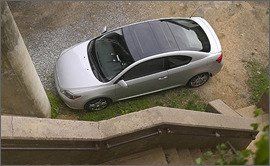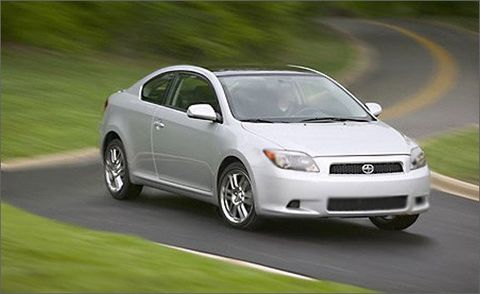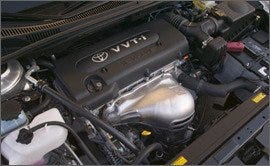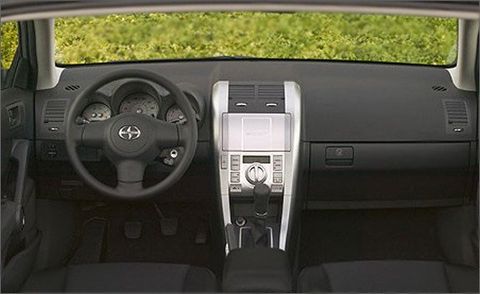Scion Tc Speed
Just a month shy of 20 years ago, in September 1984, we got our hands on Toyota's latest and greatest pocket rocket, the Corolla GT-S. That hatchback was new for the 1985 model year and promised big excitement in a small package. Chief among its list of attributes was the new 4A-GE engine-a 1.6-liter, twin-cam, 16-valve beauty that put out 112 horsepower and 97 pound-feet of torque. It also came with rear disc brakes instead of drums, a high-performance 14-inch wheel-and-tire package, and a firm sport suspension. Our test GT-S went from 0 to 60 mph in 9.5 seconds and reached a top speed of 113 mph-results we referred to as "hardly shabby."
Although those numbers would be "hardly acceptable" today, back then they made us take notice. A Chevy Camaro Berlinetta needed 10.0 seconds to reach 60 and a Nissan 300ZX required 9.2. It's no surprise, then, that we labeled the GT-S "an excellent, well-rounded little GT" that was "as playfully satisfying as anything we've recently driven." Our conclusion: "It's no wonder the Japanese have been keeping such little jewels to themselves."

AARON KILEY
Since its debut last year, Toyota's youth-oriented Scion brand hasn't offered us much in the form of jewels, lest you believe the doorstop xA and the toolbox xB to be of the precious variety. Sure, they're affordable, practical, and entertaining, but they're not exactly the small cars we leadfeet clamor to redline.
Luckily, Scion-er, Toyota-has been holding in its Japanese mine a diamond in the rough, one whose pressure cooker produced a gem of similar vein nearly two decades ago.
That recently cultivated sparkler is the Scion tC, a sporty hatchback comprising a catalog of standard features that should frighten the competition. As the first vehicle developed exclusively for Scion (the xA and the xB are rebadged Japanese-domestic-market cars), the tC, like its cute siblings, is offered in monospec form and comes more loaded than a frat boy in Cancún. At a low $16,465, the tC is equipped with a panoramic sunroof with front and rear glass panels, the former power retractable; a Pioneer CD player with MP3 and satellite-radio capabilities; dual front airbags and a driver's knee airbag; keyless entry; cruise control; A/C; power up and down windows; and an outside-temperature gauge. The only factory-installed options are front-seat-mounted side airbags and curtain airbags ($650) and a four-speed automatic transmission ($800).
Although the tC's options list is short, its dealer-accessories list is long. Scion believes in allowing its patrons to customize their vehicles, so the tC can be fitted with a variety of add-ons. Our test car came with such items as a Bazooka subwoofer ($449) and an interior light kit ($250) that casts blue Luxaura light under the dash and in the cup holders.

AARON KILEY
That feature aside, the tC is decked out with a smart, upscale interior with rich fabrics, plastics, and metallic-look accents, and the large HVAC knob actually is aluminum. The three-gauge cluster is straightforward and pleasant to eyeball, and although the silver-colored center stack is easy on the eyes, its silver-colored buttons are not always easy to decipher, especially if glare is coming through the sunroof. The 60/40 split rear seats are roomy and comfy for two, despite the presence of three seatbelts, and headroom is lacking due to the glass ceiling and long, sleek hatch. At least the back seats recline and fold flat, a feat the fronts can perform, too, assuming you slide them all the way forward and remove the headrests. Scion claims an 8.5-foot surfboard can fit in the tC. What you can't fit is a ton of gear. With the back seats up, the tC has just 13 cubic feet of cargo space, whereas the Honda Civic Si has 16 and the Mazda 3 five-door wagon has 17.
The tC shares its platform with the Avensis, a sedan Toyota sells in Europe and one whose Euro flavor has rubbed off on the Scion in the styling department. From the front, save for the BMW 7-series-like "eyebrows" that accentuate the headlights, the tC bears a striking resemblance to the latest Volvo S40, especially in the rectangular grille and raised hoodlines. In profile and from the rear, the tC becomes more Asian, showing cues from the Acura RSX and Hyundai Tiburon. Overall, we like the tC's sophisticated look and assertive stance, accentuated by short overhangs and a lengthy 106.3-inch wheelbase—6.7 inches longer than the Tiburon's.

AARON KILEY
In addition to the Avensis, the tC borrows readily from another, more familiar Toyota product. Powering the tC is the Camry's 2AZ-FE 2.4-liter four-cylinder, a sophisticated engine with an aluminum block, a magnesium cam cover, electronic throttle control, and variable intake-valve timing. Hooked to a low-restriction, two-way muffler, the 2.4 generates 160 horsepower and 163 pound-feet of torque. The Civic Si and the Mazda 3 s have as much horsepower, but they can't match the tC's twist, mustering 31 and 13 fewer pound-feet, respectively. The Camry also donates to the tC its buttery five-speed manual, albeit with a revised linkage and shorter gear ratios and the optional four-speed auto. Disc brakes are standard at every corner and feature ABS with electronic brake-force distribution.
The tC's suspension setup is similar to the Civic Si's—McPherson struts up front and multilink in back—but the tC wears larger 17-inch split-spoke alloys shod with Z-rated 215/45R-17 Bridgestone Potenza RE92 tires, the same spec rubber used on some Lexus IS300s.
Speaking of the Lexus IS, the tC is nearly as quick as its 215-hp luxury cousin. The sporty Scion scoots from 0 to 60 in 7.4 seconds and through the quarter-mile in 15.7 seconds at 88 mph, only 0.1 and 0.2 second, respectively, behind the IS ("$35,000 Sports Sedans," March 2004). Moreover, because the tC is geared fairly short—final drive is 4.24—its 30-to-50-mph top-gear time of 8.5 seconds is a 10th quicker than the six-cylinder IS's. Talk about "hardly shabby." Against its natural rivals, the tC is equally competitive. To 60, it is quicker than the Civic Si (8.0) and the Mini Cooper (8.3). It's even with the Mazda 3 s and just 0.4 slower than the supercharged Cooper S, which is the only one of the group to outgun the tC to the quarter-mile, nipping it by 0.2 second. And remember, the blown Mini starts at $20,449.

AARON KILEY
Under normal driving conditions, the tC is a satisfyingly quick and fun-to-drive hatch. The engine is a refined unit that revs willingly—and quickly—to its 6200-rpm redline, making the slick, short-throw shifter a busy partner. Not a bad thing, considering it operates with the effortless action of a Global sashimi knife slicing through a chunk of toro. But should you not feel like the next Iron Chef, no big deal—the engine creates enough torque not to require frequent shifting.
In the screeching-halt department, the disc brakes offer up direct response and reassuring performance. From 70 to standstill, the tC needs 179 feet of asphalt, 10 more feet than the Cooper S and 3 s but 25 less than the Si. The culprit for the tC's otherwise estimable performance is weight. At 3016 pounds, the tC is a portly lad that makes everything else in its class look like Calista Flockhart. A Cooper S weighs 249 fewer pounds and an Si, 276. The Mazda 3 s is the only car that comes close, but it still tips the scales at 59 fewer pounds. Obviously, Scion engineers fed the tC a carb-rich diet in the form of three additional floorpan braces, three steel door beams, and the glass roof that's supported by a full welded steel structure. The upside to all the structural enhancements is that the tC feels like a vault—solid and safe.
The tC's lack of a Subway diet also affects its handling, but more objectively than subjectively. On the skidpad, it pulled 0.81 g--less grip than the Si (0.84), Cooper S (0.85), and 3 s (0.87)--yet on our 10Best handling loop, it gave the impression it could deliver much more than that. From low-speed hairpins to high-speed sweepers, the tC displayed minimal understeer and moderate body roll and an eagerness to be pushed harder. The power-assisted rack-and-pinion steering plays a big role here. Its action is light and direct, its sense responsive. The faster you go, the better it feels.
Over Michigan's rough stuff, the tC demonstrated a supple and compliant ride that still felt sporty and firm. The independent suspension soaked up bumps and divots with a level of composure that's rare in the tC's stratum, never crashing and never unsettling the car. In light of its level of amusement through the curves, we can't recall a $16,000 sport hatch that offered such an excellent compromise between ride and handling.
ÂÂ

AARON KILEY
ÂÂ
By the time you read this, Scion's rollout will be in full swing--escalating from 23 states to nationwide--headlined by the introduction of the tC. It's sort of like a rock band touring on the heels of an album release, just different.
If the $10,000 Corolla GT-S were touring today, it would cost about $18,000. Seeing that the tC undercuts that by about $1500, and offers modern-day quickness, safety, and refinement, think of it as "not shabby at all."
LARRY WEBSTER
I thought Scion's first two cars, the small xA and the goofy shoe-box xB, were neat simply because they were so different from other cars. Plus, you got Toyota quality at a cut-rate price. I expected different--and cool--with the tC, but it feels a lot like same-old, same-old. Despite the decent acceleration times, there's just not enough spunk to raise my eyebrows, and the chassis has none of the friskiness I'd want in a little coupe. It's a lot less fun than it is composed, comfortable, and refined. I know it's a few grand cheaper than my choice for cheap wheels, the Dodge SRT-4, but it feels a lot farther away in terms of performance and fun.
TONY QUIROGA
I fully expected the Scion tC to be little more than a Toyota Paseo for the new millennium. You remember the Paseo, the Tercel-based runabout that tried to entice enthusiasts on a budget but ended up only satisfying girls with big hair who couldn't quite afford a V-6 Camaro. The tC is far more. Aside from Paseo-ish exterior styling, the tC distinguishes itself with accurate and naturally weighted steering, a stiff structure, loads of standard equipment, and best of all, enough power to keep up with a base Acura RSX. It's heavy at 3016 pounds, and the weight makes itself known at the handling limit, but the solid feel and value make it more than a pretender.
TONY SWAN
This isn't the surrogate sports car the Scion people would like us to perceive. The 2.4-liter four delivers respectable go and is easier to live with than the 1.8-liter engine used in the Celica GT-S, but the tC is a little too soft to be taken seriously as a sports coupe--too much up and down in the suspension, too much body roll. There's nothing here that couldn't be improved with suspension tuning, plus a wheel-and-tire upgrade. And with its modest base price, the tC lends itself to owner enhancements. The Scion youth mission doesn't always read loud and clear in all its products, but whether you're young or not so young, it's hard to ignore a bargain.
This content is created and maintained by a third party, and imported onto this page to help users provide their email addresses. You may be able to find more information about this and similar content at piano.io
Source: https://www.caranddriver.com/reviews/a15132327/scion-tc-road-test/

0 komentar:
Posting Komentar